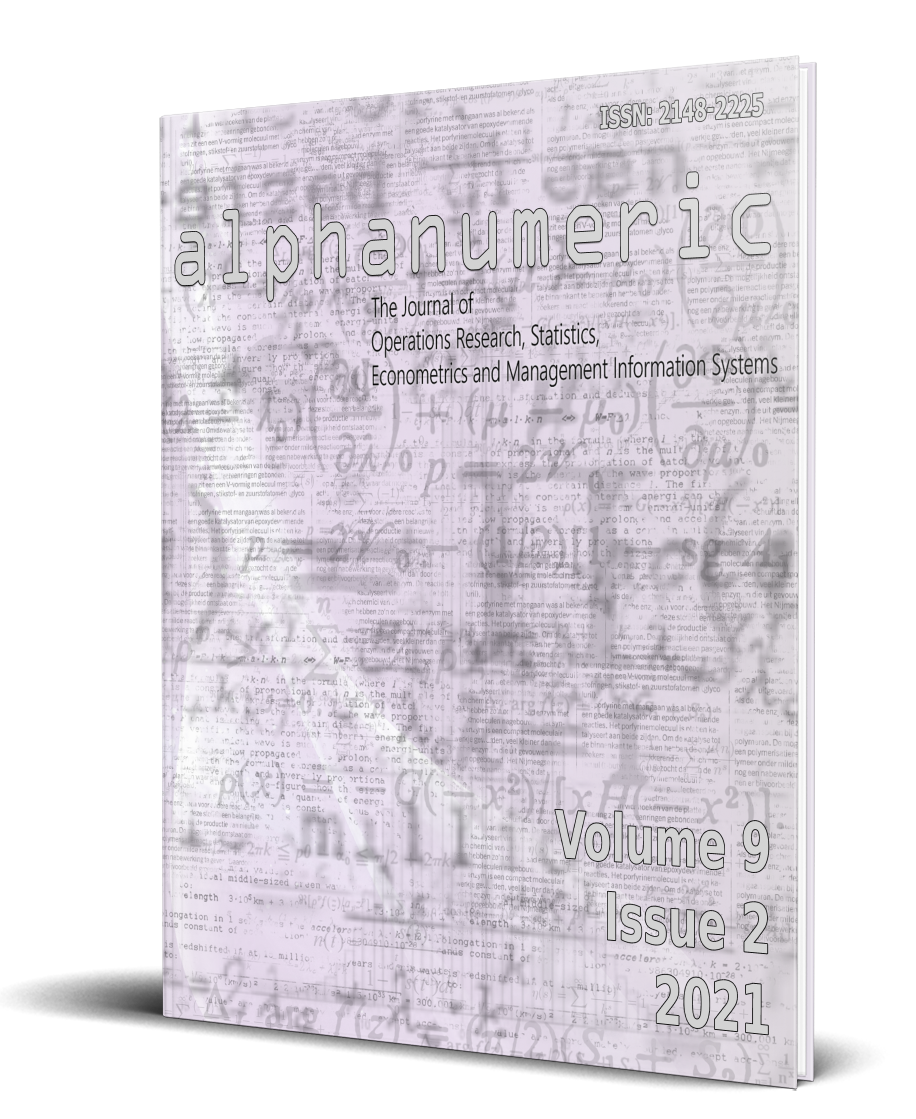
alphanumeric journal
The Journal of Operations Research, Statistics, Econometrics and Management Information Systems
Artificial Neural Network approach on Type II Regression Analysis
Abstract
In this study, the Artificial Neural Network (ANN) approach was applied to the OLS-Bisector technique, which is one of the Type II Regression techniques, through this study. In order to measure the performance of this newly created ANN-Bisector technique, it was compared with the OLS-Bisector technique. First of all, literature information on ANN and OLS-Bisector Regression techniques is given, and the features of two techniques are mentioned. In line with this information, a comparison was made between OLS based bisector technique and ANN based bisector techniques. In order to compare these two techniques, they were modeled in different distributions and in different sample sizes. In order to compare the performances of these models, the "Mean Absolute Percent Error" (MAPE) criterion was used. As a result of the study, it was seen that the ANN based bisector technique gave better results with lower error than the OLS based bisector technique. With this study, it is foreseen that it will represent an example for researchers who want to work in these fields in the future.
Keywords: Artificial Neural Networks, Measurement Error Models, Type II Regression
Jel Classification: C46
Suggested citation
(). Artificial Neural Network approach on Type II Regression Analysis. Alphanumeric Journal, 9(2), 247-258. http://dx.doi.org/10.17093/alphanumeric.972138
References
- Aygören, H., Sarıtaş, H., Moralı, T. (2012). İMKB 100 Endeksinin Yapay Sinir Ağları ve Newton Nümerik Arama Modelleri ile Tahmini. Uluslararası Alanya İşletme Fakültesi Dergisi, 73-88.
- Bayır, F. (2006). Yapay sinir ağları ve tahmin modellemesi üzerine bir uygulama. Yüksek Lisans Tezi, İstanbul Üniversitesi Sosyal Bilimler Enstitüsü. İstanbul.
- Dawson, C. W., Wilby, R. (1998). An artificial neural network approach to rainfall-runoff modelling. Hydrological Sciences Journal. 43(1), 47-66.
- Ergezer, H., Dikmen, M., Özdemir, E. (2003). Yapay sinir ağları ve tanıma sistemleri. PIVOLKA, 2(6), 14-17.
- Gazeloğlu, C., Saraçlı, S. (2013). A Simulation Study on Nonlinear Type II Regression Analysis. IAAOJ, Scientific Science, 1(1): 13-18.
- Hopfield, J. J. (1982). Neural networks and physical systems with emergent collective computational abilities. Proc. Nat. Acad. Sci. 79, 2554-2558.
- Hopfield, J. J. (1984). Neurons with graded response have collective computational properties like those of two-state neurons. Proc. Nat. Acad. Sci. 81, 3088-3092.
- Isobe, T., Feigelson, E.D., Akritas, M.G. and Babu, G.J. (1990). Linear Regression in Astronomy I, the Astrophysical Journal, 364, 104-113.
- Khan, K., Sahai, A. (2012). A Comparison of BA, GA, PSO, BP and LM for Training Feed Forward Neural Networks in e-Learning Context. I.J. Intelligent Systems and Applications, 7, 23-29.
- Matlab User’s Guide, (2020). https://www.mathworks.com/help/deeplearning/ ref/logsig.html# :~:text=logsig%20is%20a%20transfer%20function,output%20from%20its%20net%20input.&text=and%20returns%20A%20%2C%20the%20S,A%20with%20respect%20to%20N%20. Date of Access: 28.10.2020.
- Rumelhart, D. E., Hinton, G. E., Williams, R. J. (1986). Learning Internal Representation by Error Propagation. In: Rumelhart DE, McClelland JL and the PDP Research Group (eds) Parallel distributed processing, 1. MIT Press, Cambridge, Mass.
- Saraçlı S. (2008). Comparison of Linear Regression Techniques in Measurement Error Models - Monte-Carlo Simulation Study -. Doctoral Dissertation, Eskisehir Osmangazi University, Department of Statistics.
- Saraçlı, S. (2011). Tip II Regresyon Tekniklerinin Monte-Carlo Simülasyonu ile Karşılaştırılması. e-Journal of New World Sciences Academy, 6(2): 26-35.
- Saraçlı, S., Türkan, A.H. (2013). A Comparison of Linear Regression Techniques In Method Comparison Studies. Journal of Statistical Computation and Simulation, 83(10): 1890-1899.
- Saraçlı, S., Yılmaz, V. and Doğan, I. (2009). Simple Linear Regression Techniques in Measurement Error Models (Review). Anadolu University Journal of Science and Technology, 10: 335-342.
- Saylor, R.D., Edgerton, E.S. and Hartsell, B.E. (2006). Linear regression techniques for use in the EC tracer method of secondary organic aerosol estimation., Atmospheric Environment 40, 7546 -7556.
- Suresh, S., Omkar, S. N., Mani, V. (2005). Parallel Implementation of Back-Propagation Algorithm in Networks of Workstations, IEEE Transactions on Parallel and Distributed Systems, 16(1), 24-34.
- Tunca, B. (2019). Artificial neural network approach on type II regression analysis. M.Sc. Thesis, Afyon Kocatepe University Institute of Science, Afyonkarahisar.
- Uğur, A., Kınacı, A. C. (2006). Yapay Zeka Teknikleri ve Yapay Sinir Ağları Kullanılarak Web Sayfalarının Sınıflandırılması. "Türkiye'de İnternet" Konferans Bildirileri. Ankara: TOBB Ekonomi ve Teknoloji Üniversitesi. 345-349.
2021.09.02.STAT.02
alphanumeric journal
Pages 247-258
Received: July 15, 2021
Accepted: Oct. 27, 2021
Published: Dec. 31, 2021
2021 Tunca, B., Saraçlı, S.
This is an Open Access article, licensed under Creative Commons Attribution-NonCommercial 4.0 International License.

scan QR code to access this article from your mobile device
Contact Us
Faculty of Transportation and Logistics, Istanbul University
Beyazit
Campus 34452 Fatih/Istanbul/Türkiye
Bahadır Fatih Yıldırım, Ph.D.
editor@alphanumericjournal.com
+ 90
(212) 440 00 00 - 13219
alphanumeric journal
alphanumeric journal has been publishing as "International Peer-Reviewed Journal" every six months since 2013. alphanumeric serves as a vehicle for researchers and practitioners in the field of quantitative methods, and is enabling a process of sharing in all fields related to the operations research, statistics, econometrics and management informations systems in order to enhance the quality on a globe scale.

